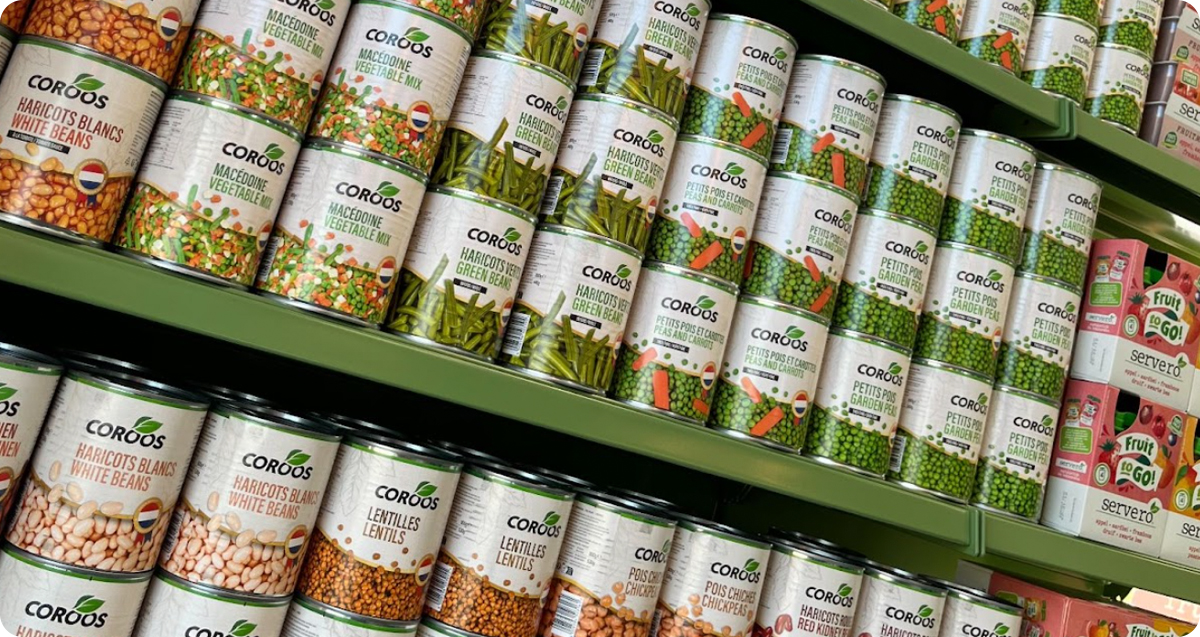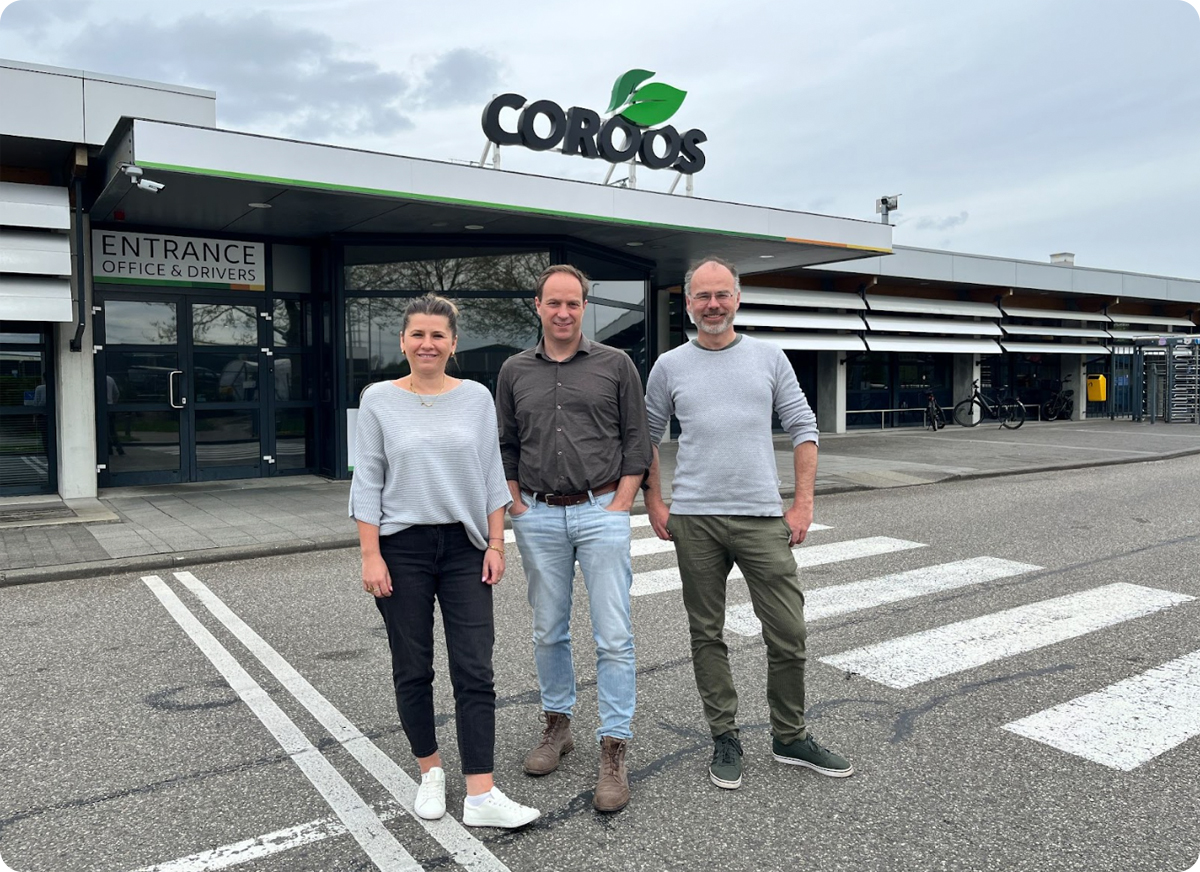April 17, 2025
We sat down to chat with the team from COROOS, one of the Netherlands’ most important pulse producers and processors. We discuss their innovation in pulse pastes, collaboration with aquafaba aficionados Fabumin, and why neither side wins in a USA/EU trade war.


Their pulse pastes and purées can be used as a component in meat or dairy, and as an alternative to gluten.
Dies Oostrom: We specialize in the canning of fruit and vegetables – in tins usually, but also in glass and plastics and aseptic volume packaging. The two factories we have have different focuses: one specializes in vegetables and pulses, the other in fruit and purées. We've been active in the pulse business since the early 1980s, selling fresh pulses like green beans, but mainly dried or soaked beans like kidneys, chickpeas, lentils, and all the coloured beans.
Gosia Kooij-Woznicka: Traditionally we have focused on retail in north-western Europe. All of the big retailers in north-western Europe are clients, 95% for private label production. Our main markets for pulses are Germany, France, the Netherlands and Belgium. Our focus lies in the big five pulses – red kidney beans, chickpeas, white beans, lentils, and brown beans, as well as other coloured beans.
GKW: Because of the unpredictability in the world these days, we have been forced to source from all over. Ten years ago we could get pulses from the same source year after year, but weather conditions have forced us to diversify our sources. For example, this year it's possible we’ll buy chickpeas from Canada, Argentina, France, Turkey and even from India. We monitor the markets closely, then we make a decision on where to buy them. That said, our focus lies mostly in North America because of the reliability of their suppliers. Weather conditions there are excellent for growing pulses.

Gosia Kooij-Woznicka (Purchaser), Dies Oostrom (Chief Technology Officer), and Matthijs Rekers (Comms. Manager).
GKW: We would like to see more pulses in Europe, so we've decided to invest in more European pulses – especially Dutch ones! This year we signed some significant contracts for large volumes of Dutch pulses such as red beans, white beans, black beans. We are also having conversations with growers here about more exotic types like borlotti or small reds. Traditionally, brown beans have been grown in the Netherlands. However, for specific customers and retailers, there is an increasing demand for "exotic" beans such as red kidney and black beans. On average, around 4,000 MT of dry pulses are cultivated in the Netherlands each year.
GKW: The way Dutch farmers look at pulses is quite different to the way Canadian farmers look at pulses. We have comparatively little land, so if you want to grow pulses you will definitely be looking at some long lasting relationships – it won't be for one year or two years. This is really something you have to believe in, and we do, which is why we took the step last year to make sure we grow a certain amount of Dutch pulses in our assortment.
DO: It's an innovative product and we are very proud of it. We did a lot of research into the product and we have done it using patented technology. The purées have a wide variety of possible applications, but mostly it's about starting to replace animal proteins. When you first look at the product, honestly, you think: "What is this!?" – but it’s just a big block of pure plant energy. It can be used as a hybrid component with meat, or even as an ingredient in dairy. Big commercial brands will only use the liquid ‘milk’ from pulses, but we use the whole bean and make it ready to ferment. It also works really well in baking as an alternative to gluten, and as a gluten-free thickener in soups. In terms of products, so far it's been used in hummus. That’s a relatively simple use, but we are now seeing some more adventurous products such as meat replacements – it shows we have a very good business case compared to extracted proteins.
GKW: Organic demand is always coming and going, depending on the economic situation. Before the Ukraine war, the French market was growing by double digit numbers. But because food prices have increased so much in the last three years, recently consumers have dropped their willingness to go for organic. When there are economic uncertainties, we see some drop in organic demand. In the last year there is a little bit more demand for organic and the market is increasing again but there are a lot of regulatory restrictions that must be met for organic growers – these are quite challenging.
DO: The final product is great. We found that two or three years ago we were cooking a lot of pulses and had a lot of wastewater – foam all over the place! We try to get rid of it, never thinking it could be as a protein. It's a blindspot you don't see because you're focused on other things. A couple of years ago we learned about aquafaba and then we met Adi from Fabumin and things came together. At the moment we are testing our factory wastewater from our new production line as we've centered the Fabumin collaboration on that line. In the coming weeks we'll do a test to see if the technology is working – although we already know it is – as a formal confirmation test. From a quality perspective, we don't see any barriers – the only objective now is to produce the aquafaba as efficiently as we can in terms of energy.
Matthijs Rekers: Absolutely. We initially aimed to become carbon-neutral by 2050, but we’re already on track to achieve that by 2030. At COROOS, the complexity lies in the diversity of our environmental impact across various processes. In some companies, sustainability goals can be met relatively straightforwardly, but in an industrial context like ours, the challenges are much more varied and intricate.
DO: We have relationships with local windmill parks, so all of the energy we buy is green. Wastewater management all adds into it too. We are in a saltwater environment here, so in the old days we would throw the water into the sea – now it's given to the farmers to be reused.
GKW: The risk of a trade war is not good news for European or US traders. There have been a lot of sleepless nights over here, as well. For some varieties of pulses, especially red kidney beans, navy beans, black beans and pintos, we are quite dependent on the US. Should tariffs be imposed on these pulses, these types would likely be the most affected. I think right now we have the calm before the storm – there is no necessity to sign big contracts because first we have to know what will happen next and adjust our strategy accordingly. We have to be 100% sure that trade tariffs will be a reality.
Disclaimer: The opinions or views expressed in this publication are those of the authors or quoted persons. They do not purport to reflect the opinions or views of the Global Pulse Confederation or its members.